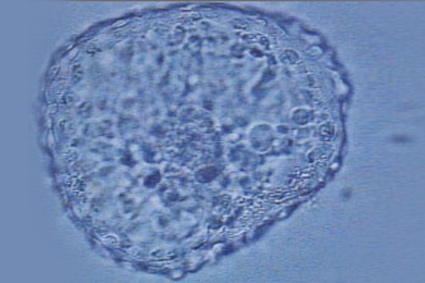Blastocyst Transfer
During the IVF treatment, the standard timing of embryo transfer has been 3 days after the egg retrieval. At this stage the embryos are between 5 and 10 cells in development.
The blastocyst is an embryo made up of 50-100 cells and reaches this stage of development 5-6 days after the egg retrieval. At this point the blastocyst divides in two types of cells: an inner core which will transform later in the fetus and an external lining which will become the placenta. If the process devlopes normally the blastocyst should come out from its shell in the 6th day and should begin the implantation 24 hours after that.
Blastocyst transfer represents the process of transferring the day 5 embryos. At this point is easier to choose the healthy embryos to be transferred to the uterus. The blastocyst transfer has become more and more popular and is a better alternative of transferring the day 3 embryos.
Recent researches show that embryos which aren’t able to survive the blastocyst phase have an abnormal number of chromosome.
Advantages of Blastocyst Transfer
- The greatest advantage is that it allows the selection of the better quality embryos as they are allowed to develop for a longer period of time and those can be selected to be transferred in the uterus.
- The blasocysts are transferred to the uterus at the time that the embryos would have entered into the uterus in a natural way. Unlike the day 3 embryo transfer that takes place at the time when the embryos should be still in the fallopian tubes. That is why the blastocyst transfer is a more natural way of fertilization.
- The extended time of the development of the embryos to blastocyst stage allows a “self-embryo selection” and thus permitting the transfer of a lower number of embryos. Hence reducing the chances of high order or multiple pregnancies and decreasing the complications to mother and the baby. The success rate of the in vitro fertilization procedure has increased with the blastocyst embryo transfer.

Disadvantages of Blastocyst Transfer
- Couples can lose a large number of embryos because many of them don’t survive the blastocyst stage.
- Blastocyst embryos require a very well equipped laboratory and special attention because they need a certain temperature and special conditions.
- If couples decide to freeze their embryos they can only do that with day 3 embryos, blastocysts can’t survive the cryopreservation.
Candidates of Blastocyst Transfer
- Young women who are less than 35years with good ovarian reserve are the best candidates for this procedure.
- Couples who have a small number of embryos for transferring or who didn’t succeed 3 embryos transfer or women who need to avoid multiple pregnancy because their health state does not allow it are the best candidates for this transfer.